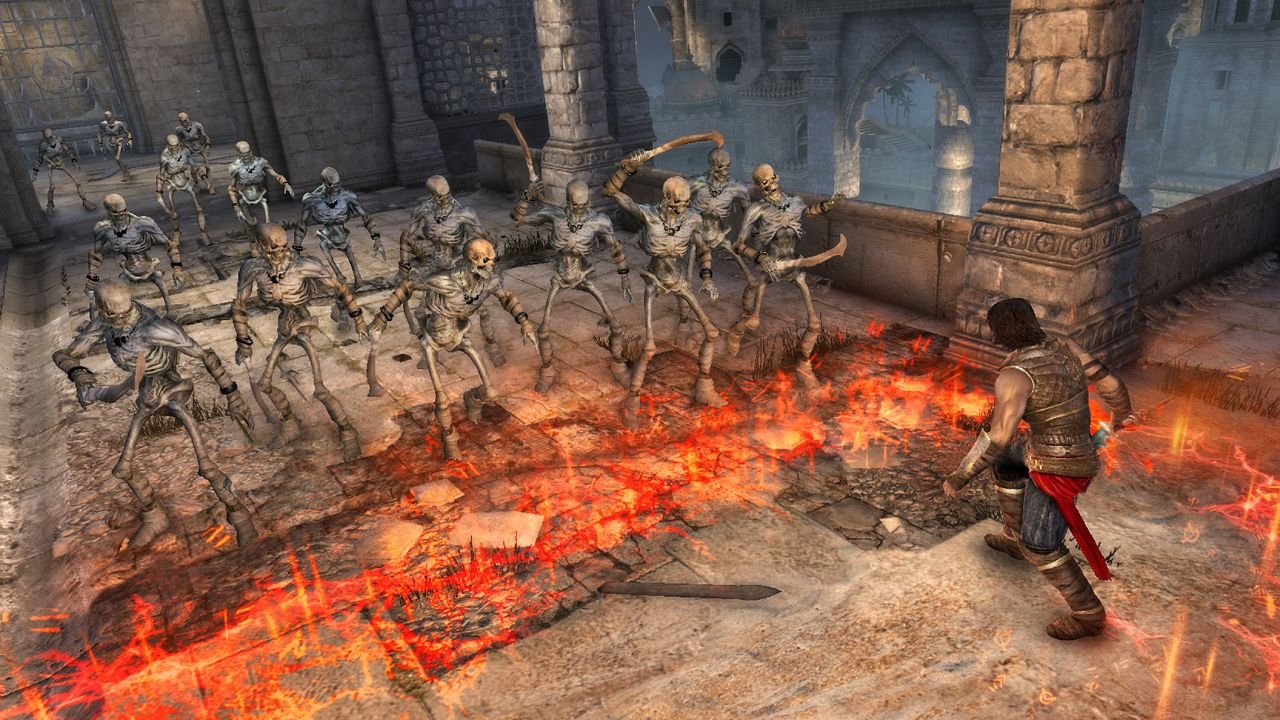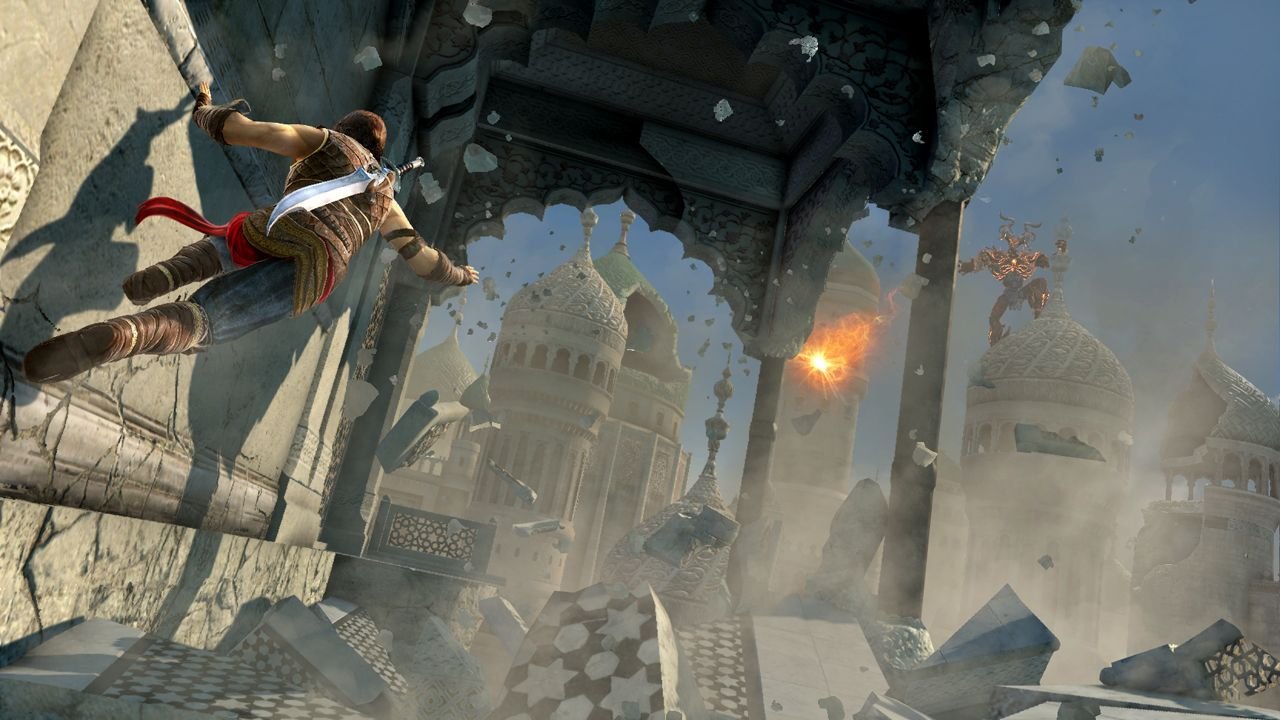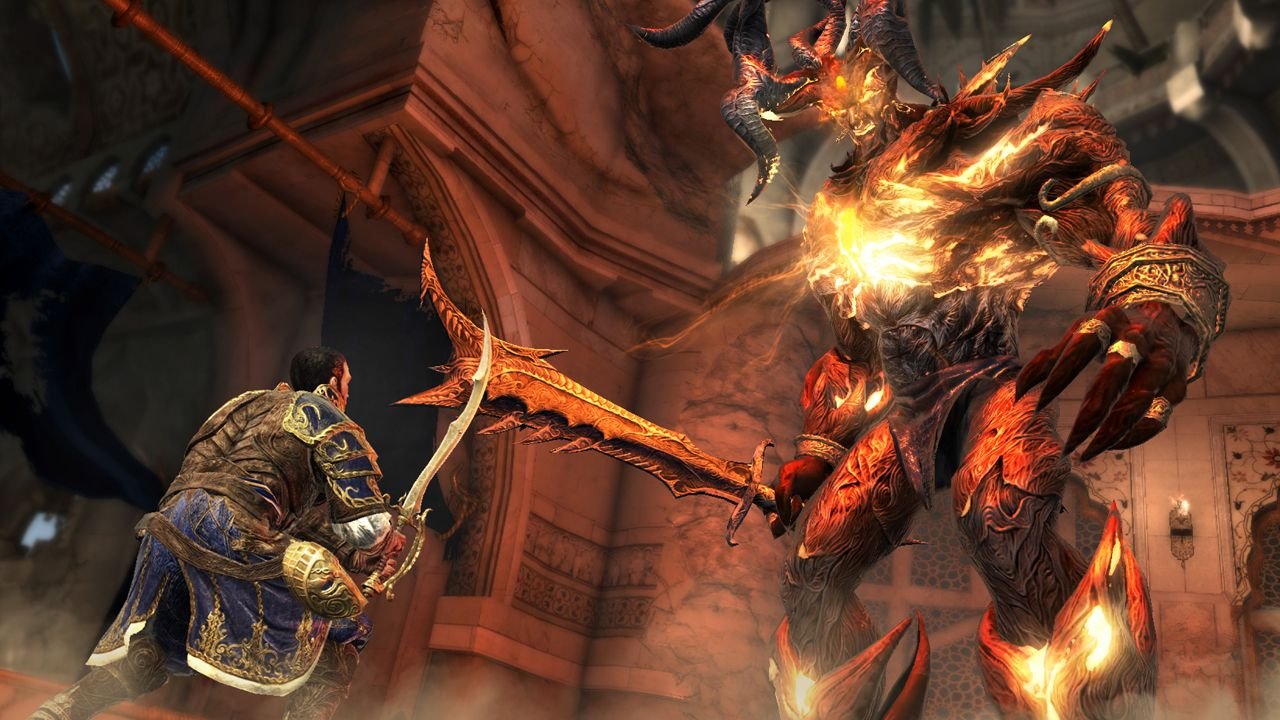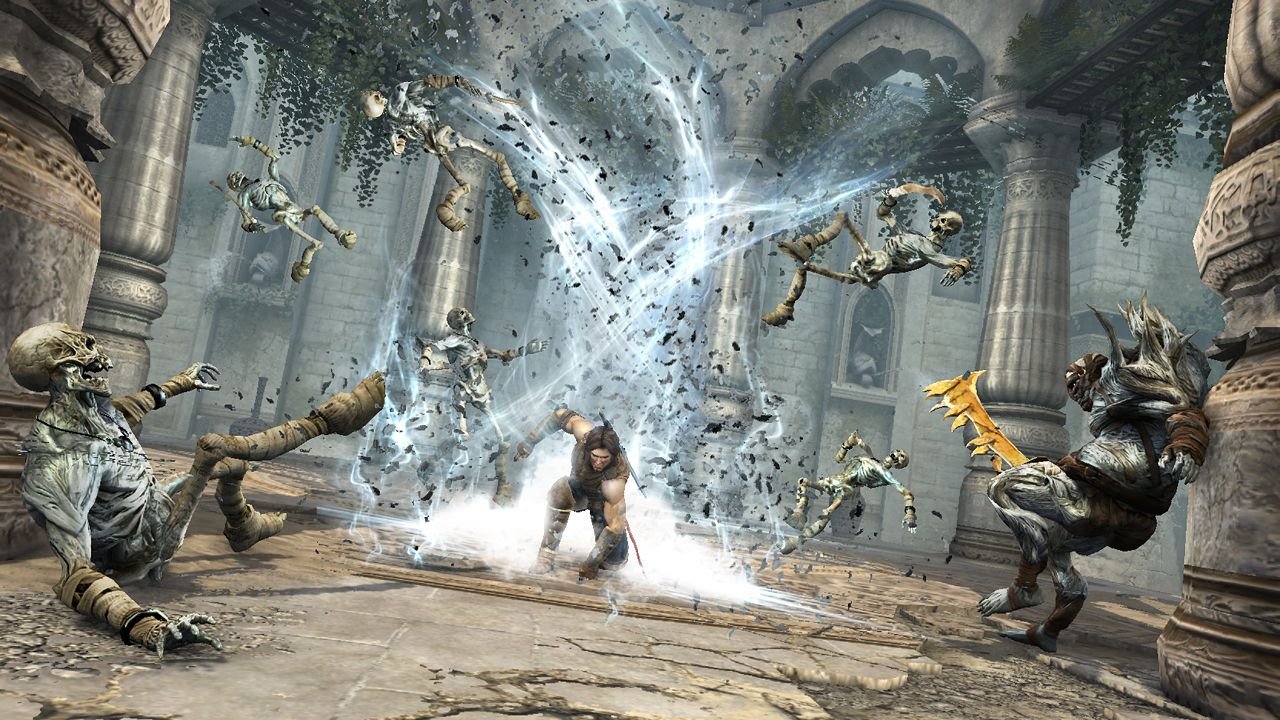Prince of Persia: The Forgotten Sands Extended Hands-On
Death-defying leaps, booby-trapped hallways, and casual time travel all make a return in the prince's latest adventure.
Bending the rules of physics and freezing water in midair may seem like a step too far, yet in the world of Prince of Persia, rules have never applied. Impossible wall climbs, death-defying leaps, and travelling back in time are par for the course. The Forgotten Sands brings the series back to its roots, combining the prince's other-worldly skills with spike traps, precision platforming, and epic boss battles.
Another Crab's Treasure Is A Soulslike 3D Platformer | GameSpot Review Stellar Blade Review Nintendo 64 – April 2024 Game Updates – Nintendo Switch Online Super Monkey Ball Banana Rumble - Official Multiplayer Features Trailer PUBG | Erangel Classic Returns Gori: Cuddly Carnage | Meow Launch Date Announcement Trailer Genshin Impact - "Arlecchino: Afterglow of Calamity" | Collected Miscellany Marvel Rivals - Official Loki Character Reveal Trailer | The King of Yggsgard Fortnite Festival - Official Billie Eilish Cinematic Season 3 Trailer Remnant 2 - The Forgotten Kingdom | DLC Launch Trailer Stellar Blade - Official "The Journey: Part 2" Behind The Scenes Trailer | PS5 Games Dead by Daylight | Tome 19: Splendor | Reveal Trailer
Please enter your date of birth to view this video
By clicking 'enter', you agree to GameSpot's
Terms of Use and Privacy Policy
The Forgotten Sands takes place between the events of The Sands of Time and Warrior Within. It tells the story of the prince who, on his journey back from Azad, discovers his brother Malik's kingdom is being attacked by the Sand Army. To save his people, Malik attempts to control the Sand Army using a mystical magic. However, rather than save them, this unleashes a powerful evil that turns the palace's occupants into statues. We went hands-on with the first hour of the game, where we witnessed the Sand Army's general, Ratash, attempting to destroy what remained of the palace.
Following a short cutscene, we were immediately set upon by a horde of enemies, which allowed us to get to grips with the combat system. Pressing X launches an attack with the prince's sword. Landing multiple hits on enemies will automatically form combos, which you can also combine with jumps, rolls, and kicks. Rolling and jumping can be used to get out of harm's way when surrounded by enemies. Jumping also allows you to leap over enemies and knock them to ground, where you can finish them off with a quick stab to the chest. Kicking has the same effect as well, knocking smaller enemies to the ground and pushing larger enemies back. This is useful for pushing them off the side of buildings and cliffs or into a wall where a brutal animation sees the prince stab them straight through the stomach.

This initial confrontation introduced us to two different creatures, which we then encountered regularly throughout the game: specters and wraiths. Wraiths look like skeletons that are armed with swords. They are the weakest enemy in the game and are easily dispatched with a few swift sword swipes. Specters are much tougher than wraiths because they are covered in heavy armour. They take several hits to destroy, though this is offset by their slow movement, which easily allows you to dodge their attacks. Much tougher enemies are introduced later on, including ghouls and summoners. Ghouls are wraiths armed with shields and some light armour. In order to destroy them, you must first kick them, which makes them move their shields, allowing you to unleash some attacks. Summoners continuously summon wraiths, as well as other Sand Army minions, and must also be knocked over with a kick. If you try to attack them head-on, they use magic to propel you away from them, which depletes a significant amount of your health bar.
After dispatching the first group of enemies, we had to make our way to a platform in another part of the room. Whenever dexterous jumping was required, the camera panned out to show us what section to aim for and the path required to get there. Firstly, we had to wall-run using the right trigger and leap to a pole suspended directly behind it. From there, we were able to swing to other poles and eventually jump onto a ledge section. There, we came across our first tricky platforming section. Two buzz saws were moving up and down the wall together, preventing us from reaching a column in the middle of the room. We had to time our wall-run just right to move past the saws and leap to the column. Finally, we jumped across to a set of climbable bricks in the wall, avoided more buzz saws, and jumped from one final pole to the platform.

A much tougher section followed, requiring us to wall-run past some buzz saws, push a button to raise a gate, and finally leap to a pole from the button to roll underneath the rapidly closing gate. In these tougher sections, the prince's ability to rewind time becomes invaluable. If you mess up one part of a platforming chain, pushing the right bumper allows you to rewind the last few seconds to the point before you made the mistake. This makes difficult sections much less frustrating. However, using it depletes a blue crystal from your inventory. You can only hold up to four at any time, and they can only be replenished by killing enemies or by smashing nearby barrels.
After more platforming, we encountered our first boss battle against the Sand Army general, Ratash. He was a large muscular creature, with a gold face mask and not much of an IQ. As such, he was easy to dispatch. Ratash uses the charging enemy mechanic that was featured several times in Batman: Arkham Asylum. We waited for him to charge and at the last second rolled out of the way, causing him to knock himself out on a wall. Once stunned, we could launch a few well-placed sword strikes before he came to; this process was repeated until Ratash gave up the ghost and turned to sand.
Following Ratash's death, we were introduced to some trickier platforming sections, which tested our timing. In the centre of a corridor was a spinning spiked log that was swinging up and down from chains. We had to run toward the log and time our jump just right to make it over. Later sections featured multiple logs (some moving vertically), swinging axes, arrows that fired from walls, and floors that had spikes pushing through them. We had to use all the prince's abilities to make it over them, using quick combinations of wall-running, jumping, and precision timing. Some of these sections were also combined with platforming elements, such as poles and buttons, making them even trickier.
Another Crab's Treasure Is A Soulslike 3D Platformer | GameSpot Review Stellar Blade Review Nintendo 64 – April 2024 Game Updates – Nintendo Switch Online Super Monkey Ball Banana Rumble - Official Multiplayer Features Trailer PUBG | Erangel Classic Returns Gori: Cuddly Carnage | Meow Launch Date Announcement Trailer Genshin Impact - "Arlecchino: Afterglow of Calamity" | Collected Miscellany Marvel Rivals - Official Loki Character Reveal Trailer | The King of Yggsgard Fortnite Festival - Official Billie Eilish Cinematic Season 3 Trailer Remnant 2 - The Forgotten Kingdom | DLC Launch Trailer Stellar Blade - Official "The Journey: Part 2" Behind The Scenes Trailer | PS5 Games Dead by Daylight | Tome 19: Splendor | Reveal Trailer
Please enter your date of birth to view this video
By clicking 'enter', you agree to GameSpot's
Terms of Use and Privacy Policy
Once past the spinning logs of death, we had to solve some simple puzzles. One of them required us to open a set of gates in the palace, which handily also had a platform that would allow us to progress. Unfortunately, a stuck cog was preventing the gate mechanism from opening. We had to move another cog along a set of tracks to the other, which then turned and freed the gate. There were three levers in front of us; one controlled movement of the cog, while the other two moved two L-shaped sections with teeth, onto which the cog needed to catch. To get the cog to the correct place, we had to rearrange the L-shaped sections in the correct order. They did not move independently; thus, the challenge was to know when to move the sections and when to rotate the cog.
More platforming puzzles followed, after which a blue portal appeared and we were able to meet Razia for the first time. Razia is a Djinn--a being with magical powers--who gifts you with powers of your own. It's not clear from our preview build why she is helping you, though Ubisoft told us her intentions become clearer later in the game. Initially, Razia gives you the power over water, allowing you to freeze it and use it as if it were solid. Freezing water depletes your energy bar as you hold down the trigger, so you can't keep it frozen indefinitely. Later, she gives you another power, which allows you to leap over greater distances by locking onto enemies and rushing toward them in midair. You use both these mechanics extensively, with your water abilities adding another layer of difficulty to the platforming.

Later in the game, we encountered Infirit, which was a huge fire demon in charge of the Sand Army. To get to Infirit, we had to traverse a collapsed part of the palace, where water was spouting out of the walls and ceiling. We froze the water and used it as a pole to swing to other sections. However, not all the water spouted out at the same time. We had to juggle jumping from water poles with turning our ability on and off midair. This allowed the water to flow and turn into another pole onto which we could grab. We also had to freeze a waterfall to wall-run up it and reach another platform. Using the water ability can be tricky at first because it requires precise timing and finger dexterity, particularly when combined with other platforming elements. However, it is very satisfying when you are able to pull off a long string of moves, which results in an elegant-looking set of character animations.
When we reached Infirit, it immediately started attacking. Unlike the other bosses, Infirit did not charge at us. It instead chose to swipe at us with its sword, unleashing ground-pounding attacks and launching fireballs. We had to roll in toward it, hit it a few times with our sword, and then roll out again to avoid its attacks. Once we had its health bar down to its halfway point, a quick-time event appeared that required us to push the X and Y buttons to stab it. Afterward, Infirit leapt away, and we had to traverse more spouting water columns to catch up with it. Before we could kill it, the prince's brother Malik leapt in and ran his sword down Infirit's back, finishing it off.

Though much of our time was spent inside the grime-ridden palace interior, there were other sections that showed off Ubisoft's Anvil game engine. One section took place in the bath house, which had been unaffected by the battle with the Sand Army. It was full of lush waterfalls and gleaming blue tiles that reflected the splashes of the water. Outdoor sections showed off the draw distances of the engine, which were also used to good effect in Assassin's Creed II. Distant palace rooftops were easily visible, and the rising plumes of smoke from buildings added an air of destroyed beauty to the skyline. Prince of Persia: The Forgotten Sands is set for release on May 18 for the PlayStation 3, Xbox 360, and PC.
Got a news tip or want to contact us directly? Email news@gamespot.com
Join the conversation